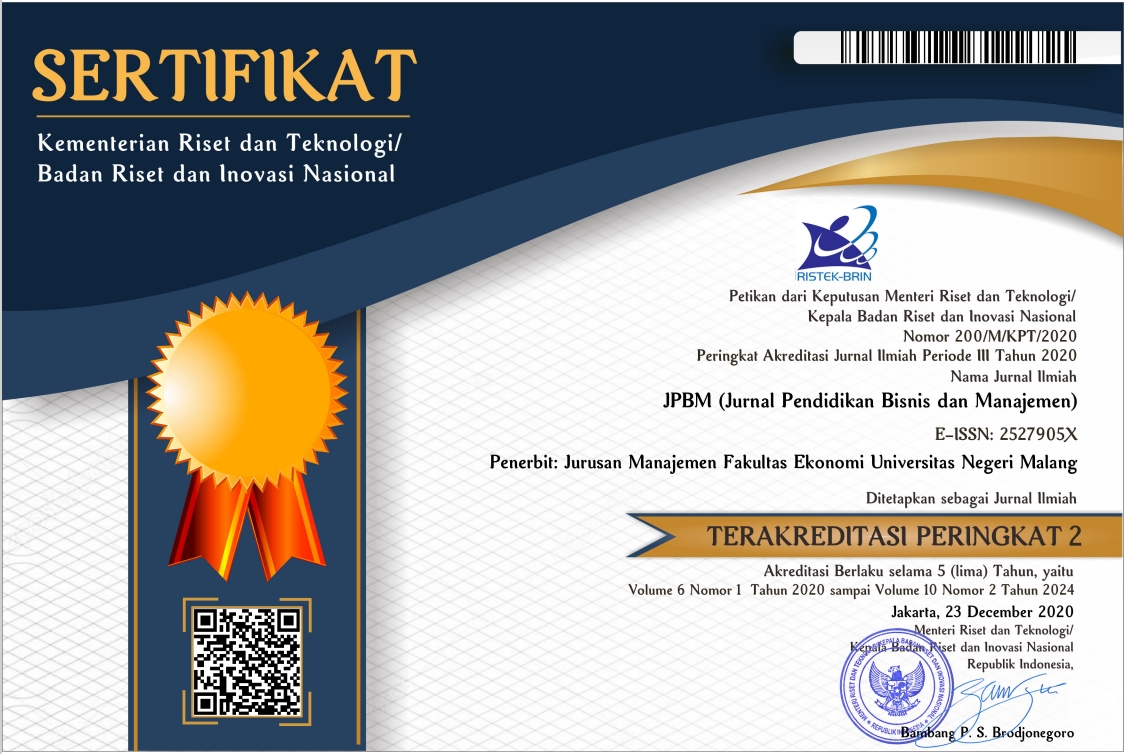Does Personalized Advertisement Influence Behavioral Intention and Customer Engagement? Study in Gen-Z Instagram Users
Abstract
There is an increasing study on the effect of personalized advertising from the traditional approach, but few studies have examined the effect of social media advertising, especially Instagram. Using the partial least structural equation modeling (PLS-SEM) method, this study examines the effects of personalized advertising perceived by consumers (consisting of perceived personalization, ad credibility, ad skepticism, and ad avoidance) on Instagram toward the reaction of consumers’ attitudes and behavior. This present study involved 421 sample data of Gen-Z Instagram users who had used the social media application in recent weeks during the study. The findings of the study prove that personalized advertising can increase positive responses of consumers (e.g., increase the credibility and attitude of advertisements) and reduce their negative responses to advertisements (e.g., advertising skepticism and advertising avoidance). This positive response is proven to increase the likelihood of consumers buying and their involvement in personalized advertising. The implication and recommendation are also provided in this paper.
Keywords: Personalized advertising, ad credibility, ad skepticism, ad avoidance, attitude towards advertising, Instagram, Gen-Z
Full Text:
PDFReferences
Aaker, J. L., Brumbaugh, A. M., & Grier, S. A. (2000). Nontarget markets and viewer distinctiveness: The impact of target marketing on advertising attitudes. Journal of Consumer Psychology, 9(3), 127–140. https://doi.org/10.1207/S15327663JCP0903_1
Algesheimer, R., Borle, S., Dholakia, U. M., & Singh, S. S. (2010). The impact of customer community participation on customer behaviors: An empirical investigation. Marketing Science, 29(4), 756–769. https://doi.org/10.1287/mksc.1090.0555
Baek, T. H., & Morimoto, M. (2012). Stay away from me. Journal of Advertising, 41(1), 59–76. http://dx.doi.org/10.2753/JOA0091-3367410105.
Bang, H., & Wojdynski, B. W. (2016). Tracking users’ visual attention and responses to personalized advertising based on task cognitive demand. Computers in Human Behavior, 55, 867–876. https://doi.org/10.1016/j.chb.2015.10.025
Chakraborty, G., Lala, V., & Warren, D. (2003). What do customers consider important in B2B websites? Journal Advertising Research, 43(10), 50–61. https://doi.org/10.1017/S0021849903030071
Chen, P. T., & Hsieh, H. P. (2012). Personalized mobile advertising: Its key attributes, trends, and social impact. Technological Forecasting and Social Change, 79(3), 543–557. https://doi.org/10.1016/j.techfore.2011.08.011
Cho, C.-H., & Cheon, H. J. (2004). Why do people avoid advertising on the Internet? Journal of Advertising, 33(4), 89–97. https://doi.org/10.1080/00913367.2004.10639175
Choi, S. M., & Rifon, N. J. (2002). Antecedents and consequences of web advertising credibility. Journal of Interactive Advertising, 3(1), 12–24. https://doi.org/10.1080/15252019.2002.10722064
Cotte, J., Coulter, R., & Moore, M. (2005). Enhancing or disrupting guilt: The role of ad credibility and perceived manipulative intent. Journal of Business Research, 58, 361–368. https://doi.org/10.1016/S0148-2963(03)00102-4
Dawson, S., & Kim, M. (2010). Cues on apparel web sites that trigger impulse purchases. Journal of Fashion Marketing and Management, 14(2), 230–246.
Haenlein, M., & Kaplan, A.M. (2004). A beginner’s guide to partial least square analysis. Understanding Statistics, 3(4), 283–297. https://doi.org/10.1207/s15328031us0304_4
Hair, J. F. Jr., Hult, G. T. M., Ringle, C. M., Sage, M. S., & Ketchen, D. J. (2017). A Primer on partial least squares structural equation modelling. SAGE Publications Vol. 46, pp. 184–185.
Jung, A. R. (2017). The influence of perceived ad relevance on social media advertising: An empirical examination of a mediating role of privacy concern. Computers in Human Behavior, 70, 303–309. https://doi.org/10.1016/j.chb.2017.01.008
Kabadayi, S., Price, K. (2014). Consumer–brand engagement on Facebook: liking and commenting behaviors. Journal of Research in Interactive Marketing, 8, 203–223. https://doi.org/10.1108/JRIM-12-2013-0081
Knowles, E. S., & Linn, J. A. (2004). Resistance and Persuasion, Psychology Press.
Mackenzie, S.B., & Lutz, R. J. (1989). An empirical examination of the structural antecedents of attitude toward the ad in an advertising pretesting context. Journal of Marketing, 53 (2), 48–65. https://doi.org/10.1177/002224298905300204
Mehrabian, A., & Russell, J. A. (1974). An Approach to environmental psychology. Cambridge, Massachusetts: MIT Press.
Nielsen. (2016). Gen Z: Konsumen Potensial Masa Depan. October 19, 2016. Retrieved from https://www.nielsen.com/id/en/press-releases/2016/gen-z-konsumen-potensial-masa-depan/
Obermiller, C., & Spangenberg, E. R. (1998). Development of a scale to measure consumer skepticism toward advertising. Journal of Consumer Psychology, 7 (2), 159–186. https://doi.org/10.1207/s15327663jcp0702_03
Sahoo, D., & Pillai, S. S. (2017). Role of mobile banking servicescape on customer attitude and engagement: An empirical investigation in India. International Journal of Bank Marketing, 35(7), 1115–1132. https://doi.org/10.1108/IJBM-09-2015-0144
Speck, P. S., & Elliott, M. T. (1997). Predictors of advertising avoidance in print and broadcast media. Journal of Advertising, 26(3), 61–76. https://doi.org/10.1080/00913367.1997.10673529
Tran, T. (2017). Personalized ad on Facebook: An effective marketing tool for online marketers. Journal of Retailing and Consumer Services, 39, 230–242. https://doi.org/10.1016/j.jretconser.2017.06.010
Tran, T. P., Muldrow, A., & Ho, K. N. B. (2021). Understanding drivers of brand love-the role of personalized ads on social media. Journal of Consumer Marketing, 38(1), 1–14. https://doi.org/10.1108/JCM-07-2019-3304
Tong, S., Luo, X., & Xu, B. (2020). Personalized mobile marketing strategies. Journal of the Academy of Marketing Science, 48, 64–78. https://doi.org/10.1007/s11747-019-00693-3
Tucker, E. M., Rifon, N. J., Lee, E. M., & Reece, B. B. (2012). Consumer receptivity to green ads: A test of green claim types and the role of individual consumer characteristics for green ad response. Journal of Advertising, 41(4), 9-23. https://doi.org/10.1080/00913367.2012.10672454
DOI: http://dx.doi.org/10.17977/um003v9i12023p001
Refbacks
- There are currently no refbacks.
JPBM (Jurnal Pendidikan dan Bisnis Manajemen) is licensed under a Creative Commons Attribution-NonCommercial-ShareAlike 4.0 International License.
JPBM (Jurnal Pendidikan dan Bisnis Manajemen) is abstracted and indexed in :

















